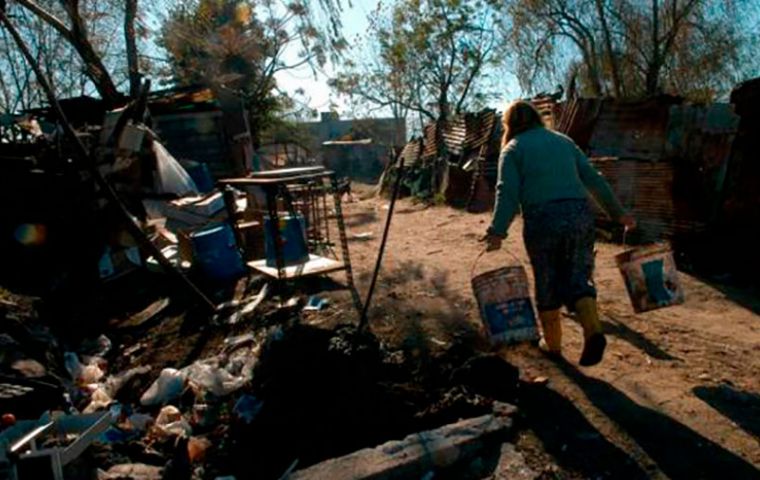MercoPress. South Atlantic News Agency
Poverty in Latin America affects 32% of the total population; 28% don't study or have paid jobs, ECLAC report
 Figures mean an additional 15 million people will be living in poverty compared to before the pandemic and 12 million more people in extreme poverty
Figures mean an additional 15 million people will be living in poverty compared to before the pandemic and 12 million more people in extreme poverty In Latin America and the Caribbean some 200 million people live in poverty, with 82 million in extreme poverty, points out a report from the UN Economic Commission for the region, ECLAC. The numbers are equivalent to 32,1% and 13,1% of the total population and need to be urgently addressed to avert the risk of a lost generation.
Despite the slight decline recorded in 2021, projections indicate that poverty and extreme poverty rates remain above pre-pandemic levels in 2022 in Latin America and the Caribbean, warned in its Social Panorama 2022.
“After a sharp increase in poverty and a slight increase in income inequality in 2020 as a result of the COVID-19 pandemic, the extreme poverty and poverty rates declined in 2021 and the middle-income strata grew, but not enough to fully reverse the negative effects of the pandemic,” the report explains. ECLAC projects that by the end of 2022, poverty will stand at 32.1% of the population (a percentage equivalent to 201 million people) and extreme poverty at 13.1% (82 million), which points to a slight decline in overall poverty and a slight increase in extreme poverty versus 2021, due to the combined effects of economic growth, labor market dynamics and inflation.
These figures mean that an additional 15 million people will be living in poverty in comparison with the situation before the pandemic and that there will be 12 million more people in extreme poverty than there were in 2019.
The extreme poverty levels projected for 2022 represent a 25-year setback for the region, the regional organization underscores.
As in past years, ECLAC indicates that the incidence of poverty is greater in some population groups in the region: more than 45% of the child and adolescent population lives in poverty, and the poverty rate of women from 20 to 59 years of age is higher than that of men in all of the region’s countries. Similarly, poverty is considerably higher in the indigenous and Afro-descendent populations.
In 2021, income inequality (as measured by the Gini index) declined slightly versus 2020 in Latin America, reaching 0.458, which was similar to 2019 levels.
Meanwhile, the unemployment projected for 2022 represents a setback of 22 years, particularly affecting women, whose unemployment is seen rising from 9.5% in 2019 to 11.6% in 2022.
Likewise Latin America and the Caribbean experienced the longest educational blackout worldwide (with an average shutdown of educational establishments of 70 weeks, versus 41 weeks in the rest of the world), which exacerbated pre-existing inequalities related to access, inclusion and educational quality. In this period, one of the main limitations on educational continuity was unequal access to connectivity, equipment and digital skills. In 2021, in 8 out of 12 of the region’s countries, more than 60% of the poor population under 18 years of age had no connectivity in their household.
Furthermore in Latin America, the percentage of young people from 18 to 24 years of age that neither studies nor does paid work increased from 22.3% in 2019 to 28.7% in 2020, especially affecting young women (36% of them were in this situation, compared with 22% of men).
Social spending by central governments reached 13% of GDP in 2021 in Latin America, below the level seen in 2020 but far above what had been recorded in the last two decades. In the Caribbean, social spending reached 14.1% of GDP in 2021, marking a historic high.
In 2021, education spending amounted to 4.1% of GDP (30.5% of total social spending) in Latin America and the Caribbean. “While public spending on education in the countries of the Organization for Economic Co-operation and Development (OECD) in 2019 averaged 4.9% of GDP, a figure similar to that of the region (4% of GDP in 2019), spending per student in OECD is six times the equivalent in Latin America and the Caribbean in pre-primary, 5.7 times in primary, 5.3 times in secondary and 6.1 times in tertiary,” the publication specifies.
“We are facing a cascade of crises that has exacerbated the region’s inequalities and shortfalls. This is not a time for gradual changes, but instead for transformative and ambitious policies,” José Manuel Salazar-Xirinachs, ECLAC’s Executive Secretary, underlined




Top Comments
Disclaimer & comment rulesCommenting for this story is now closed.
If you have a Facebook account, become a fan and comment on our Facebook Page!